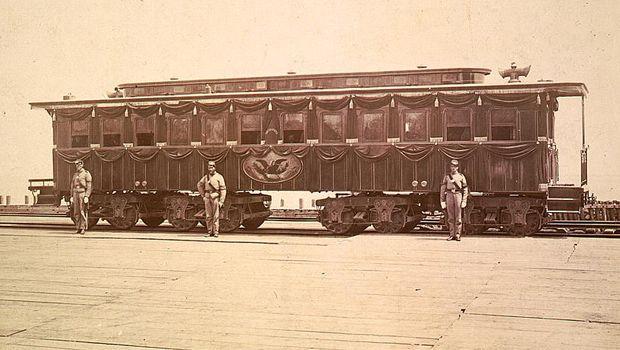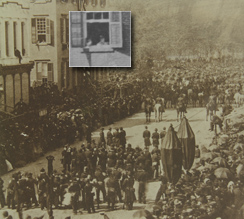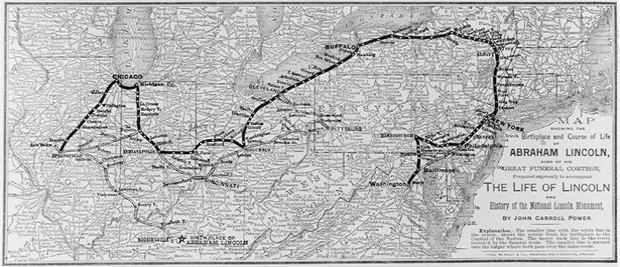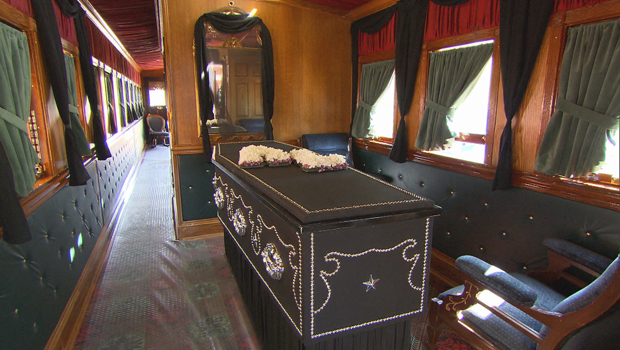Lincoln's funeral train is reborn
The assassination of President Abraham Lincoln shocked the country 150 years ago this past month. Coming just days after Lee's surrender to Grant, Lincoln's death plunged the nation into new uncertainty ... and prompted a very long goodbye. Martha Teichner sets the scene:
A stunned, sad sea of mourners lined the streets in the rain as Abraham Lincoln's casket was taken from the White House to the Capitol on the day of the assassinated president's funeral.
Tens of thousands of people filed past the body lying in state. But millions would see it as Lincoln made what is probably the most extraordinary train journey in American history, home to Springfield, Illinois.
"People traveled for miles over rugged country just to see the train that carried the body of President Lincoln," said Robert Reed, who wrote an account of Lincoln's funeral train. "They got in a horse-drawn wagon, they got on horseback, they walked. These weren't interstates; these were very primitive paths to the rail tracks."
The train carried not just Lincoln's body but that of his 11-year-old son, Willie, who had died of typhoid fever in 1862.
It left Washington on April 21, 1865, its route covering nearly 1,700 miles. It stopped in state capitals and major cities such as Philadelphia, New York, Cleveland, Chicago -- but avoided the places where Confederate sympathizers might have made trouble.
"A presidential car was under construction at the time of the assassination," said Reed. "It was almost completed. It was more or less what you consider the Air Force One of today. But when the assassination occurred, there was a dramatic change, and they tore all the inside structure out of that and made it a hearse car."
It was draped in black, the coffin placed on an elevated platform.
"Even at night, they had special lights so you could actually see in and see the casket," said Reed.
Imagine -- the entire way, not just in towns and cities, hundreds, sometimes thousands of people stood along the tracks for hours.
"There's over 400 places, cities and towns and villages and even little bypasses that the train went through, and it slowed down and maybe stopped," said Reed.
During each stop, the casket was removed, and the same spectacle repeated. One photograph shows a young Theodore Roosevelt staring down at the procession to City Hall in New York City, where more than 100,000 people viewed Lincoln's remains.
At each stop, whites and blacks stood side by side, although at times uneasily.
In New York, there was an attempt, at least, to keep African-Americans out of the procession, said Howard University professor Edna Greene Medford, one of the few African-American Lincoln scholars.
"In almost every procession, although African-Americans were there, and they were allowed to participate in these processions, they were put at the back of the line," said Medford.
Lincoln had ended slavery, but what next was unclear.
"African-American grief, I think, is shaped not just by the fact that the country had lost this great leader, but African-Americans felt that they had lost their future," Medford said, "because they really counted on Lincoln to protect them. And so now that protection had been taken away."
The train passed through Knightstown, Indiana, on Sunday, April 30 -- Day 10 of its 13-day trip to Springfield. As is the case in most of the towns and cities it passed through, there is no marker, nothing to recall the event, which is why historian Robert Reed, a resident of Knightstown, wrote his book, "Lincoln's Funeral Train: The Epic Journey from Washington to Springfield" -- struggling to finish before dying of cancer last June.
"People in the town would be singing hymns and chanting prayers and saying 'God bless Lincoln,'" Reed told CBS News last year. "And as that faded away into the distance in the dark, you could then hear the next town, the next village of people doing the very same thing."
An embalmer and a funeral director were on the train full time, constantly attempting to refresh the unrefrigerated corpse, less and less successfully.
Once Lincoln was buried on May 4th, amazingly nobody thought to preserve or display the historic hearse car. It was sold several times, and eventually was destroyed by fire in 1911. Souvenir hunters were told to take what they wanted.
For the last five years, in Elgin, Illinois, Dave Kloke and several train enthusiast friends have been building a replica of Lincoln's hearse car, as close to accurate as possible. He showed Teichner a lamp from the original train: "The lamp here, we believe, was on the car. We have some documentation that says it was."
They matched photographs of the outside; the inside was harder. "The only photograph we have is when it's in disrepair at the end of its life," said Kloke. "That's how we figured out where the stateroom was."
And there is an exact replica of his coffin.
Last weekend, during the 150th anniversary commemorations of Lincoln's final homecoming, the complete replica hearse car was on display in Springfield.
"We worked on the car all the way to Tuesday when we came down here, right up to the last minute," said the guide.
It was a labor of love for the two dozen or so volunteers who built it by hand.
They've raised less than half of its $350,000 cost. They'd like to see it in a museum. But so far, there's been no interest.
And just like the first time around, the re-enactment of that final, solemn procession: the bearing of Abraham Lincoln's casket through the streets of Springfield at last, to the vault where he would be laid to rest took center stage.
But unlike in 1865, the builders of this replica are determined that Lincoln's funeral car and its remarkable story will not be lost again.
WEB EXTRA:Lincoln assassination: The other murder attempt
As the president was shot at Ford's Theatre, a former Confederate soldier attempted to kill Secretary of State Seward, and failed spectacularly.
For more info:
- "Lincoln's Funeral Train: The Epic Journey from Washington to Springfield" by Robert M. Reed (Schiffer)
- The 2015 Lincoln Funeral Train (Official site)
- Follow on Facebook and Twitter (@2015Lincoln)



